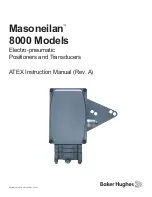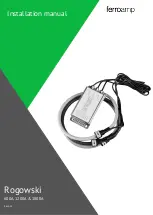
102
AW T4 20 |
U N I V ER S A L 4 - W I R E , D UA L- I N P U T T R A N SM I T T ER | O I/AW T4 2 0 - EN R E V. B
…Appendix C Dual 2-electrode conductivity calculations
Monitoring on AVT systems
For low conductivity feedwater applications, all volatile
chemical treatment (AVT) is often applied.
Where cation resin columns are used to remove the effects on
the conductivity measurement of volatile ammonia and
hydrazine chemical treatment, it is common practice to
measure both before- and after-cation conductivity. The
sensitivity of the conductivity measurement to chemical
treatments is increased by passing the sample through the
cation column.
If it is known that a sample contains only one impurity (e.g.,
ammonia), the conductivity measurement now becomes an
indication of the concentration of that impurity and it is then
possible to calculate the pH of the sample from the
concentration data. The result is referred to as 'inferred pH'.
The maximum after-cation conductivity value is programmable
between 0.060 and 10.00 µS cm
-1
dependent on local
conditions. After-cation values above this level generate an
AFTER CAT. HIGH
error message and before-cation values
above 25.00 µS cm
-1
generate a
BEFORE CAT. HIGH
error
message. The inferred pH range is 7 to 10 pH, values above
10pH generate an
Infr. pH
invalid error message.
Refer to page 83 for message descriptions.
The inferred pH feature can be used on AVT systems only in
the following circumstances:
1
On steam raising plant.
2
For boiler chemical treatment such as ammonia and/or
hydrazine. In this instance,
A: Temp. Comp
. must be set to
NH3
and
B: Temp. Comp.
must be set to
ACID
.
3
Where the after-cation conductivity value is insignificant
compared to the before-cation value.
NOTICE
Inferred pH measurement on AVT systems is inappropriate
to chemical treatments such as sodium phosphate, sodium
hydroxide and morpholine.
Monitoring on AVT systems with impurities
Differential conductivity can also give an indication of sample
pH on AVT systems where there are low concentrations of ionic
impurities present in addition to the volatile alkaline agent (e.g.
sodium ch ammonia). In this case, the exchange of
ammonium and sodium ions within the cation column releases
water and hydrochloric acid. The sodium chloride impurity
produces a conductivity after the column that is higher than
the conductivity before.
The dual input analyzer, when used to monitor before- and
after-cation conductivities, compensates for this increase and
calculates the inferred pH of the incoming sample. The user-
configurable, after-cation conductivity alarm can be used to
detect unacceptably high levels of impurities in the sample and
inform the user of the validity of the inferred pH value.
The calculated inferred pH is proportional to:
BC – (AC – 0.055)/R
Where:
BC
=
the before column reading
AC
=
the after column reading
0.055 =
the conductivity of pure water at
25 °C in µS cm
-1
R
=
a ratio factor depending on the BC
and AC readings
The maximum after-cation conductivity value is programmable
between 0.060 and 25.00 µS cm
-1
dependent on local
conditions. After-cation values above this level generate an
AFTER CAT. HIGH
error message and before-cation values
above 25.00 µS cm
-1
generate a
BEFORE CAT. HIGH
error
message. The inferred pH range is 7 to 10 pH, values above 10
pH generate an
Infr. pH invalid
error message. Refer to page
83 for a description of error messages.
The inferred pH feature can be used on AVT systems with
impurities only in the following circumstances:
1
On steam raising plant.
2
For boiler chemical treatment such as ammonia and/or
hydrazine. In this instance,
A: Temp. Comp
. must be set to
NH
3
and
B: Temp. Comp
. must be set to
ACID
.
3
Where the after-cation conductivity value is less than
25.00 µS cm
-1
.
NOTICE
Inferred pH measurement on AVT systems is inappropriate
to chemical treatments such as sodium phosphate, sodium
hydroxide and morpholine.









































